Updated: Nov 2017 – Added new Leica lenses and terminology to the list.
Leica Lens Terminology
Hello again folks! It’s time to take another headfirst dive down the rabbit-hole that is manufacturer lens terminology, acronyms, and abbreviations. If you read my Sony article you will no doubt already be familiar with exactly how complex the world of lens terminology can be so brace yourselves, it’s time to tackle German premium camera and optics manufacturer Leica!
Leica’s (Leitz Camera) roots can be traced back to Germany, 1913; Oskar Barnack, working for Ernst Leitz Optische Werke (then the world’s largest producer of microscopes) built the company’s first prototype 35mm camera. The design was revolutionary, using an extremely compact body and a horizontally scrolling film, a design language still widely utilized today. In 1925 the Leica Model A (or Leica 1) made its debut, featuring a fixed 50mm Elmax f/3.5 lens. Rumor has it that this first Leica lens was named after designer Max Berek’s dog, also named ‘Max’. The Leica Model A was the world’s first mass produced 35mm format camera, representing a revolution in camera design that still resonates throughout the industry today.
Leica are viewed by many photography aficionados as being the world’s leading manufacturer of premium cameras and optics, the high water-mark of the industry; Today we will be taking a look at lenses made for their interchangeable camera systems.
Leica do not produce as wide a range of lenses as larger manufacturers, nor are Leica products mass produced on a scale of the likes of Canon or Nikon, Leica lenses are however seen as being the absolute best that money can buy. The company’s design philosophy is completely uncompromising; Leica only manufactures lenses in combinations of focal-length and aperture that will guarantee the highest possible optical quality, let’s take a closer look and see how they name and specify them.
Lens Types
Note: Sensibly, all Leica lenses have the model name in the following format embossed around the exposed front lens element: SUMMICRON-M 1:2.0/35 ASPH ((CLASS)-(FORMAT) 1:(APERTURE)/(FOCAL LENGTH) (EXTRA INFO))))). Some lenses will include further information for example ‘VARIO’ expressed as VARIO-SUMMICRON-M.
Don’t worry, you will get the hang of it!
Macro
Leica Macro lenses are the company’s range of lenses designed for macro, or close-up photography. A good Macro lens should feature a 1:1 magnification ratio for taking highly detailed, life sized images of subjects. Leica Macro lenses contain the term ‘macro’ in the model name, for example the Leica MACRO-ELMAR-M 90mm f/4 Lens
Most popular Macro lenses: Leica Macro-Elmar-M 90mm f/4 | Leica APO-Macro-Summarit-S 120mm f/2.5 CS | Leica APO-Macro-Elmarit-TL 60mm f/2.8 ASPH
Tilt/Shift Lenses
Leica ‘Tilt/Shift’ (Canon Tilt-Shift, Nikon Perspective Control) lenses allow the shooters to alter the angle between the focal plane and the camera sensor. This adjustment allows compensation for the Keystone effect, which causes parallel lines in an image to converge if the camera is not perfectly level. Tilt/Shift lenses can also be used to increase depth of field at wide apertures, and are extremely popular with landscape and architectural photographers. Leica Tilt/Shift lenses are identifiable by the acronym ‘TS’ in the lens model name for example the Leica 120mm f/5.6 TS-APO-ELMAR-S ASPH lens, currently the only Leica Tilt/Shift.
CS Lenses
A Leica CS lens is a lens that contains a ‘Central Shutter’ built into the lens barrel. Using a central shutter, also known as a leaf shutter, allows flash-sync at higher speeds than a traditional focal plane shutter and also produces less vibration. These qualities are a result of the central shutter mechanism, which uses an aperture style blade arrangement, weighing much less than a focal plane shutter mechanism. Leica CS lenses are only available for the ‘S’ medium format system and have the acronym ‘CS’ at the end of the model name, for example the Leica APO-TELE-ELMAR-S 180mm f/3.5 CS Lens.
Most popular CS lenses: Leica APO-Macro-Summarit-S 120mm f/2.5 CS | Leica Summarit-S 35mm f/2.5 ASPH CS | Leica Elmarit-S 45mm f/2.8 ASPH CS
Lens Formats
M
The M-mount is Leica’s longest serving camera mounting system; Introduced in 1953 on the Leica M3 rangefinder, M-lenses are specifically designed to be used on Leica’s range of film and digital rangefinder cameras. The ‘M’ stands for “Meßsucher” which is the German word for rangefinder. The M-mount is a bayonet style mount, all Leica M-mount lenses are manual focus only and resolve a 35mm image circle. In 2006 Leica introduced the Leica M8, the company’s first Digital M camera and has since released a number of ‘Digital M’ lenses; These are classic M-mount lenses reworked and optimized for use on digital rangefinder cameras.
Leica M-mount lenses are compatible with all of the company’s M-mount rangefinder cameras and can also be mounted on the SL and L/TL system cameras (see below) by utilizing the Leica M-Adapter-L. M-lenses are denoted by the initial ‘-M’ located after the class in the Lens model name.
Most popular M lenses: Leica Summicron-M 35mm f/2 ASPH | Leica Elmarit-M 28mm f/2.8 ASPH | Leica Summarit-M 50mm f/2.4
R
R-mount lenses (I believe the ‘R’ stands for ‘Reflex’) were lenses designed to be used with Leica’s now defunct range of SLR cameras. Leica released their first SLR, the Leicaflex in 1964 as a direct rival for the Nikon F, and the first ‘R’ branded SLR the R3 was released in 1976. Leica R-mount cameras never saw true success; The company legged behind the competition in the implementation of features such as auto-exposure metering, and never released an autofocus compatible Leica R camera or lens. Leica manufactured 75 lens designed for the R-system during its 44 year lifespan in focal lengths ranging from 15mm to a 105-280mm telephoto zoom. The system was discontinued in 2008.
Leica never produced a digital R-mount DSLR, but in 2003 they released a 10MP digital back which could be fitted to the R8 and R9. R-lenses can still be used on Leica R-mount cameras and can also be mounted on the Leica SL and L/TL system cameras (see below) by utilizing the Leica R-Adapter-L. R-lenses are denoted by the initial ‘-R’ located after the class in the model name.
Most popular R lenses: Since R lenses are now discontinued, the best place to find them is by viewing this eBay R lens search.
S
Leica S-mount lenses are lenses specifically made for Leica’s S-series of digital medium format cameras. The first S-series camera was the Leica S1, a stationary scanning camera released in 1996. The S1 did not use the Leica S-mount, instead using an interchangeable mounting system allowing the use of Leica R and M-mount lenses as well as lenses from a number of other manufacturers. The S-mount first appeared in 2008 when Leica announced the S2, a medium format camera housed in a 35mm ‘SLR like’ body. S-mount lenses are all autofocus compatible and feature a built in screw-type autofocus motor. S-lenses are denoted by the initial ‘S’ located after the class in the model name.
Most popular S lenses: Leica 30-90mm f/3.5-5.6 Vario-Elmar-S | Leica 24mm f/3.5 Super-Elmar-S ASPH | Leica APO-Macro-Summarit-S 120mm f/2.5 CS | Leica Summarit-S 35mm f/2.5 ASPH CS
L-Mount/T-Mount
The first point of importance when discussing Leica T-mount lenses is that the system has recently been renamed the L-mount. The name change simplifies Leica’s naming scheme as will become apparent throughout this section.
L-mount (formerly T-mount) lenses are designed specifically to be used with Leica’s mirrorless system cameras and first appeared in 2014 on the Leica T (Typ 701) cropped sensor mirrorless camera. Initially all T-mount lenses were designed to resolve an APS-C sized image circle. In 2015 Leica announced the SL, a full frame mirrorless camera also featuring the T-mount, which was subsequently as explained above renamed the L-mount. Lenses designed to resolve a full frame image circle, for use on the SL were named SL-lenses, and cropped lenses for the Leica T (formerly T-lenses) were from this point forward named TL-lenses. Therefore In the lens model name, after the lens class:
-SL = Full Frame.
-TL = Cropped.
-T= Cropped (only found on lenses manufactured before the name change, still system compatible).
Because the SL and the T/TL cameras use the same physical mount the lenses are interchangeable between systems, just remember to apply the required crop factor or adjust for a change in field of view as required. There are also three adapters available for the L-mount system, the M-Adapter-L, R-Adapter-L and S-Adapter-L. These allow M-mount, R-mount, and S-mount lenses to be mounted on SL and T/TL cameras. All three are are compatible with the SL, whilst only the M-Adapter-L and R-Adapter-L can be used on the leica L/TL.
SL and TL lenses are denoted by either the initials ‘SL’ or ‘TL’ located after the class in the lens model name. All L-mount lenses feature built-in autofocus, and as far as I can discern they use a stepping motor design.
Most popular SL lenses: Leica Vario-Elmarit-SL 24-90mm f/2.8-4 ASPH | Leica Summilux-SL 50mm f/1.4 ASPH | Leica APO-Vario-Elmarit-SL 90-280mm f/2.8-4
Most popular TL lenses: Leica Elmarit-TL 18 mm f/2.8 ASPH| Leica Summilux-TL 35mm f/1.4 ASPH | Leica APO-Macro-Elmarit-TL 60mm f/2.8 ASPH | Leica Vario-Elmar-T 18-56mm f/3.5-5.6 ASPH
Summilux-C/Summicron-C
Leica also manufactures a range of cinema industry standard PL-mount prime lenses. These lenses belong to either the Summilux or Summicron class of lenses and are denoted by the initial ‘C’ located after the class name. All C lenses are manual focus and extremely high quality, they are some of the best prime cinema lenses money can buy; A single Summilux-C lens will cost you up to $40,000 whilst a Summicron-C lens will cost you up to $20,000
PL Cine lens sets (you won’t believe the price!): Leica Summicron-C T2.0 Lens Set (6 Lenses) | Leica Summilux-C Lens Set (10 Lenses)
Lens Trademarks/ Classes
Since the 1960’s Leica has registered a number of trademarks which are still used today to identify the ‘class’ as I shall refer to it within which each Leica lens resides. The Lens class Identifies the aperture of each lens carrying that class name, as well as the lenses original purpose. The lens class has also become synonymous with with the quality of the lens, for example SUMMICRON class lenses represent the absolute pinnacle of Leica’s manufacturing abilities. The class name will always appear in the lens model name which is always embossed on the end of the lens barrel.
SUMMICRON
SUMMICRON lenses feature fast f/2 apertures and represent the absolute pinnacle of Leica’s manufacturing abilities. They are the highest quality lenses that can be attached to a Leica camera. The first SUMMICRON, a 50mm, was made in 1953 and was subsequently followed by 35mm, 90mm, 40mm and 28mm focal length. Until the early 2000’s these were the only focal lengths that SUMMICRON could be manufactured in without compromising quality. SUMMICRON lenses are available for the M, S, T/TL and PL mount systems. Early versions have been updated to include ASPH elements and optimization for digital photography. Expect to pay anywhere between $1,300 (TL) and $20,000 (C) dollars for a Leica SUMMICRON
Most popular SUMMICRON lenses: Leica Summicron-M 35mm f/2 ASPH | Leica Summicron-T 23mm f/2 ASPH | Leica Summicron-M 28mm f/2.0 ASPH
NOCTILUX
The Leica NOCTILUX is specifically designed for extreme low light photography, featuring apertures between f.0.95 and f/1.25 and characterized by the oversized design required to facilitate them. NOCTILUX lenses are only available for M-mount cameras and are seen as more of a collectors piece than a practical tool, their size nearly completely obscuring the camera’s viewfinder! Expect to pay at least $10,000 for a NOCTILUX lens, with the Noctilux 75mm coming in at nearly $13,000!
Most popular NOCTILUX lens: Leica Noctilux-M 50mm f/0.95 ASPH | Leica Noctilux- M 75mm f/1.25 ASPH
SUMMILUX
SUMMILUX lenses feature a fast f/1.4 aperture and are optimized for low-light photography. They are larger and tend to be more expensive than SUMMICRON lenses but cannot live up to the latter’s optical quality. The first SUMMILUX 50mm lens appeared in 1959 and lenses are now available for M, S, SL, TL and PL-mount cameras in a number of focal lengths. early versions have been updated to include ASPH elements and optimization for digital photography. Expect to pay $2,000-$8,000 for a M or S-mount SUMMILUX and up to $40,000 for a C-mount version!
Most popular SUMMILUX lenses: Leica Summilux-M 50mm f/1.4 ASPH | Leica Summilux-TL 35mm f/1.4 ASPH | Leica Summilux-M 35mm f/1.4 ASPH | Leica 21mm f/1.4 Summilux-M ASPH
SUMMARIT
The SUMMARIT name first appeared in 1949; It was the name given to Leica’s fastest lens of the time the SUMMARIT 50mm f/1.5. Unfortunately Leica decided to resurrect the name in 2007 to identify a new line of ‘affordable’ f/2.4 lenses. The new SUMMARIT lenses were seen as not living up to Leica’s philosophy of quality and therefore have not been a sales success. SUMMARIT lenses are available in M and S-mount and cost between $2,000 $6,000.
Most popular SUMMARIT lenses: Leica Summarit-M 50mm f/2.4 | Leica Summarit-M 35mm f/2.4 ASPH | Leica Summarit-S 35mm f/2.5 ASPH
SUMMARON
The origin of SUMMARON lenses can be traced back to the early 1950’s when Leica released the SUMMARON 35mm f/3.5, this was followed later in the same decade by the SUMMARON 35mm f/2.8. Both lenses featured screw mounts and were extremely compact, today we would most likely describe them as a ‘Pancake lens’. The SUMMARON 35mm lenses subsequently became available in M-mount format, and Leica has recently revitalised the SUMMARON lens family in 2016 with the announcement of the Leica SUMMARON-M 28mm f/5.6; It pays homage to its ancestors with a wonderfully mechanical and compact design that is classically ‘Leica’.
The only current SUMMARON: Leica Summaron-M 28mm f/5.6
ELMARIT
ELMARIT lenses feature an aperture of f/2.8, they first appeared in the 1960’s and are now available for SL, T/TL, S, and M-mount cameras and cost between $1,000 (M-mount) and $10,000 (S-mount).
Most popular ELMARIT lenses: Leica Elmarit-M 28mm f/2.8 ASPH | Leica Vario-Elmarit-SL 24-90mm f/2.8-4 ASPH | Leica Elmarit-S 45mm f/2.8 ASPH
ELMAR
ELMAR lenses were traditionally f/4.0 lenses but the range has now expanded to encompass lenses ranging from f/2.8 to f/4.0. ELMAR lenses are available in S, T/TL, and M-mount and cost between $1,000 (T-mount) and $10,000 (S-mount).
Most popular ELMARIT lenses: Leica Super-Vario-Elmar-T 11-23mm f/3.5-4.5 ASPH | Leica 21mm Super-Elmar-M f/ 3.4 ASPH | Leica Tri-Elmar-M 16-18-21mm f/4 ASPH
HEKTOR
HEKTOR was rumored to be the name of Oskar Barnack’s dog and the name was only used on Leica’s lowest quality lenses, the most well known example being the Leica HEKTOR 135mm f/4.5. The new Leica Sofort instant camera features an Automatik-Hektor 60mm f/12.7 Lens
THAMBAR
The original THAMBAR lens was launched in 1935, and in 2017 Leica re-released that lens with a few modern tweaks for the digital era. This is an odd duck of a lens! Instead of creating the sharpest possible lens, as manufacturers usually strive to do, the Thambar-M 90mm is intentionally soft. Aspherical elements within the lens are not properly corrected during the manufacturing process, and this gives the images a soft “glowing”, dreamy look to them which Leica claims you cannot achieve in post. *cough*. For the ability to shoot soft, blurry photos, you’ll pay nearly $7000. The photos are certainly unique… check the Leica page for samples.
The only current THAMBAR lens: Leica Thambar-M 90mm f/2.2
ELPRO
Leica Elpro products are close-up filters rather than lenses themselves. The screw onto the front of Leica lenses and reduce the minium focus distance. The Leica Elpro 52 works natively with lenses that have a 52mm filter thread, but it also includes step rings to work with 46mm and 49mm threads. Leica also make an Elpro-S which is desined specifically to work with the 180mm Elmar-S lens.
Elpro Filters: Leica Elpro 52 | Leica Elpro-s
Abbreviations and Acronyms
ASPH
ASPH lenses contain at least one Aspherical lens element. The profile of an aspherical element does not conform to the surface of a sphere. Aspherical elements are used to correct coma and various other types of lens aberrations but are costly and complex to manufacture. This makes them traditionally more expensive than their spherical counterparts. Leica lenses featuring Aspherical elements feature the acronym ASPH in the model name for example the Leica Summilux-M 50mm f/1.4 ASPH.
APO
An APO or ‘Apochromatic’ lens is designed specifically to limit both chromatic and spherical aberrations to a higher degree than a traditional achromatic lens. An APO lens does so by correcting for chromatic aberrations at three wavelengths and spherical aberrations at two wavelengths. APO lenses feature extremely complex designs to achieve such low levels of aberration and therefore are traditionally extremely expensive. APO lenses are identified by the abbreviation ‘APO’ before the lens model name, for example the Leica APO-SUMMICRON-M 50mm f/2 ASPH.
Most popular APO lenses: Leica APO-Summicron-M 50mm f/2 ASPH | Leica Telephoto 90mm f/2.0 APO-Summicron-M
TELE/TELYT
A TELE or TELYT lens is simply a telephoto lens, for example the Leica APO-TELYT-M 135mm f/3.4
SUPER
Although I cannot find a specific definition of Leica’s use of the prefix SUPER it would seem to indicate that a lens is a Super-wide angle, with a focal length of 21mm or less. Currently Leica only manufactures ‘SUPER’ lenses in the ELMAR class, like the Leica 21mm Super-Elmar-M f/ 3.4 ASPH. Not all 21mm Leica lenses have the ‘SUPER’ prefix though, for example the Leica SUMMILUX-M 21mm f/1.4.
VARIO
The appearance of the abbreviation VARIO in a leica lens model name denotes that the lens is a zoom lens.
Most popular Vario lenses: Leica 30-90mm f/3.5-5.6 Vario-Elmar-S | Leica Vario-Elmarit-SL 24-90mm f/2.8-4 ASPH | Leica APO-Vario-Elmarit-SL 90-280mm f/2.8-4
TRI
TRI lenses are zoom lenses designed to be used with the M-series of rangefinders. The viewfinders in Leica’s rangefinder cameras do not zoom ‘with’ the lens, they instead contain frame lines that indicate the field of view at three specific zoom settings. Tri lenses ‘click’ to these three settings only, hence the name. TRI lenses are identified by the abbreviation ‘TRI’ before the lens class, for example the Leica TRI-ELMAR-M 16-18-21mm f/4 ASPH
Most popular TRI lenses: Leica Tri-Elmar-M 16-18-21mm f/4 ASPH | Leica Tri-Elmar 28-35-50 f/4 ASPH (discontinued)
Pin This Post
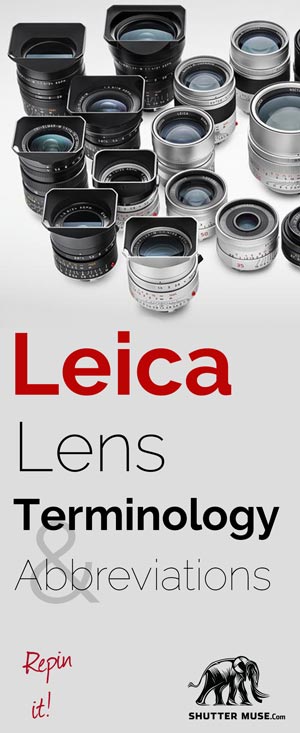





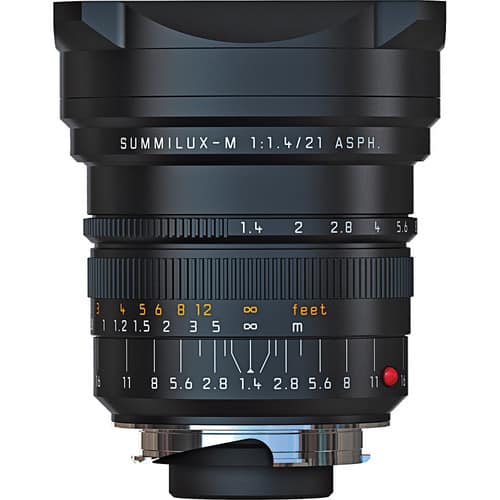


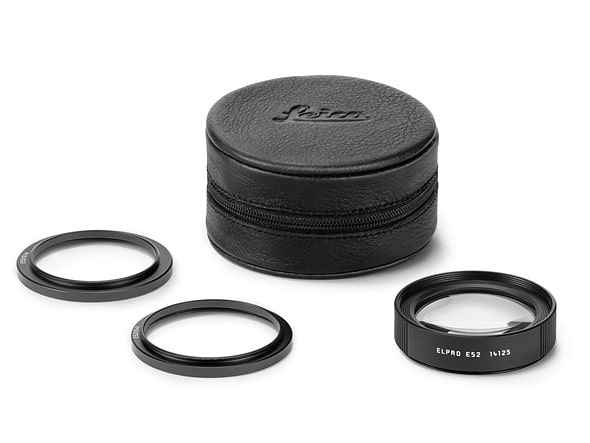

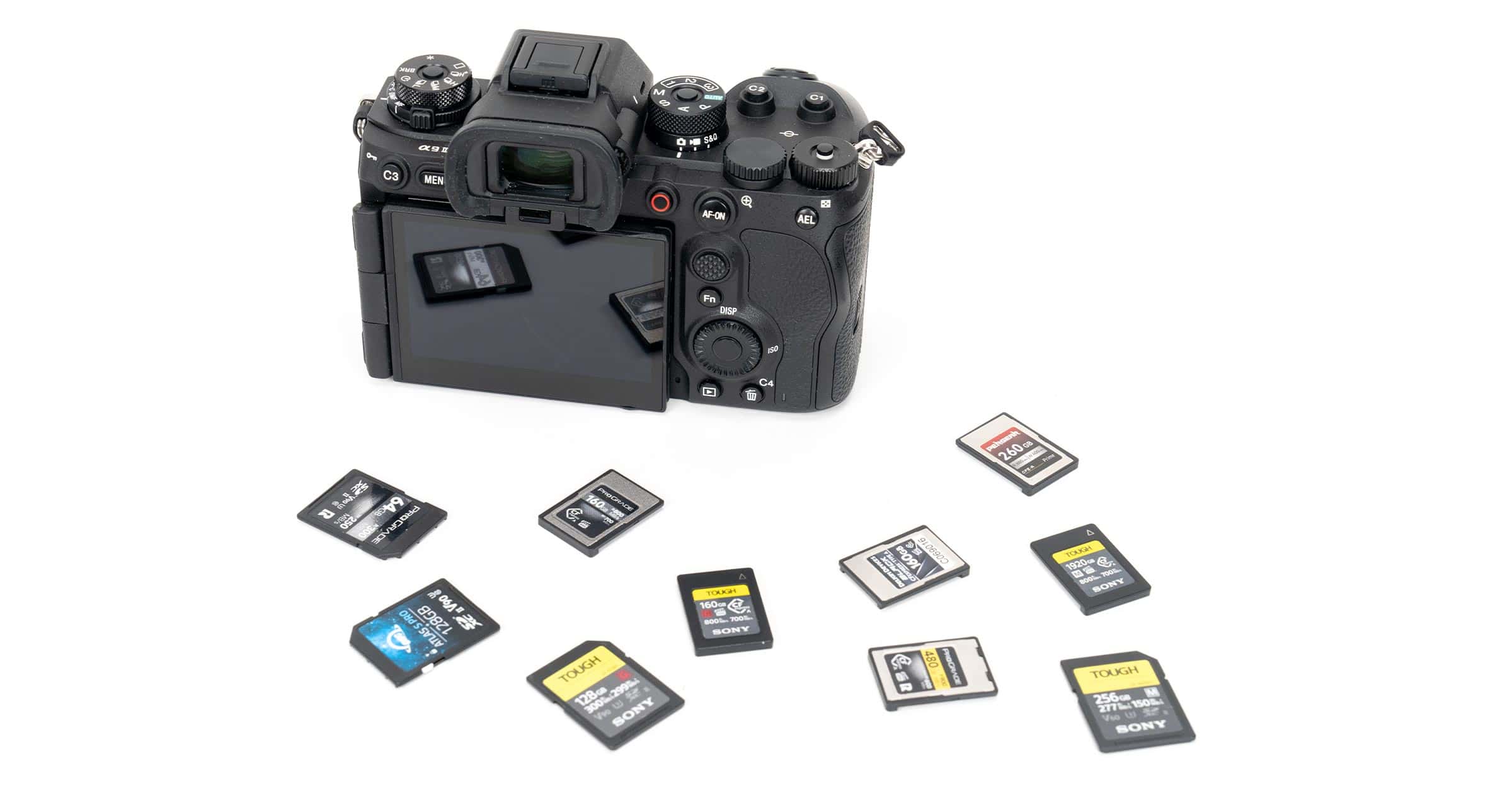
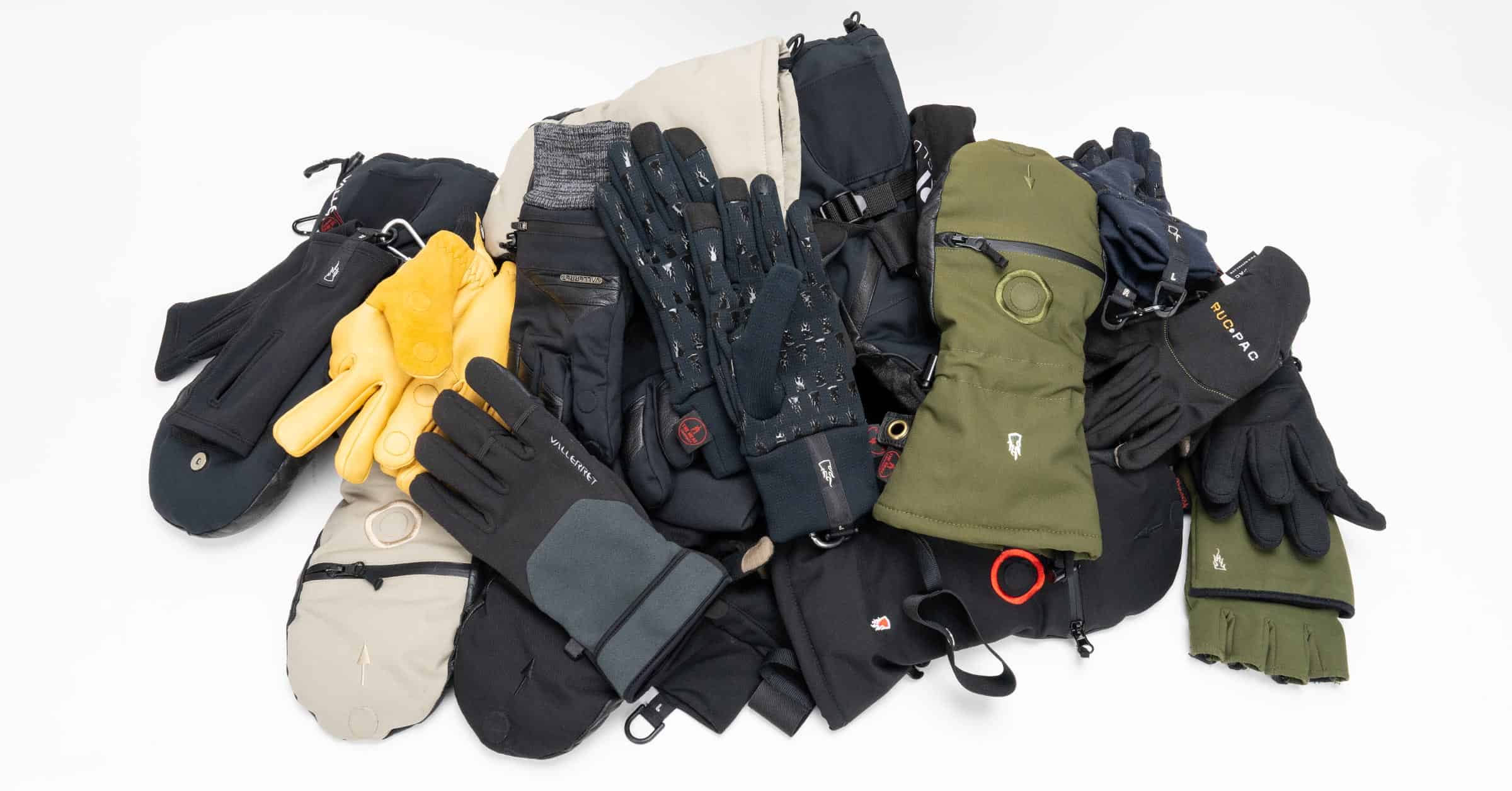

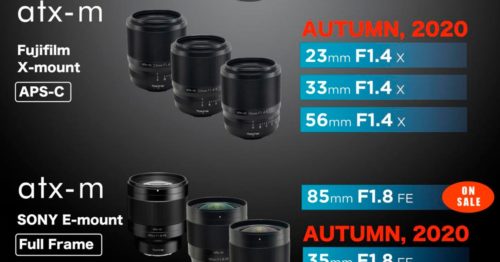
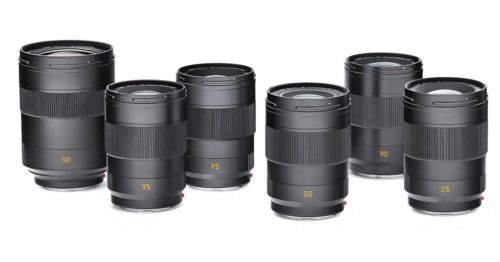

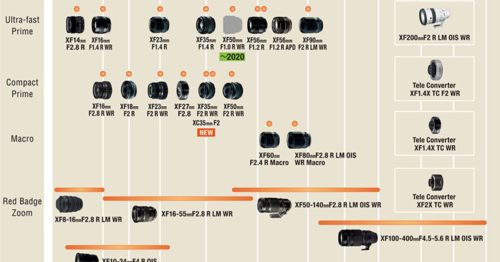
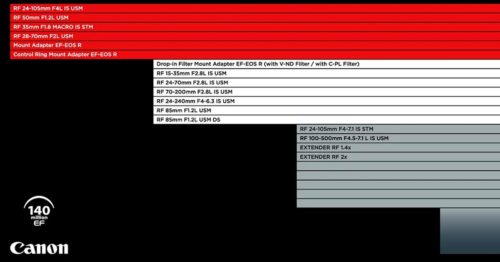
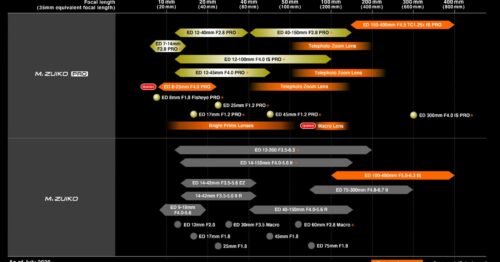
Need to understand photography better!
That’s what this site is here for 🙂
Great site! I started looking at it in the hope of finding something that would indicate when a lens needed the use of a visoflex or oubio adapter.
Two weeks ago I bought a 200mm f4.5 telyt with leica thread and could not understand why it would not focus. I took it back to the shop only to buy it back that same night after finding a visoflex1 I had bought a few years ago. I have not tried it yet but I am hopeful.
I would appreciate if you will give me any information on this subject.
I have looked all (?) over the internet but it seems to be quite vague.
Unfortunately, I can’t help you there. That goes beyond my expertise.